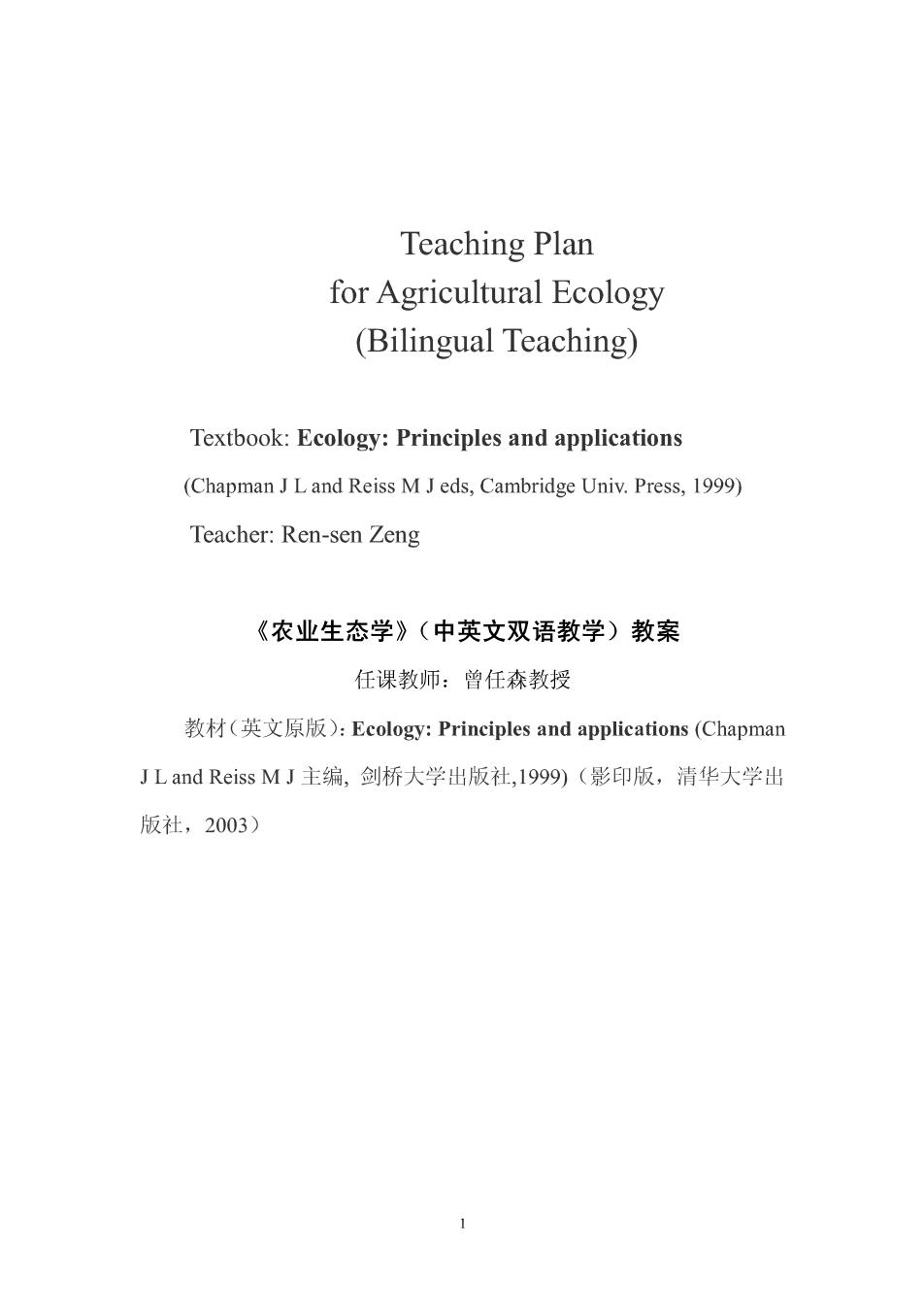
Teaching Plan for Agricultural Ecology (Bilingual Teaching) Textbook: Ecology: Principles and applications (Chapman J L and Reiss M J eds, Cambridge Univ. Press, 1999) Teacher: Ren-sen Zeng 《农业生态学》(中英文双语教学)教案 任课教师:曾任森教授 教材(英文原版):Ecology: Principles and applications (Chapman JL and Reiss MJ主编,剑桥大学出版社,1999)(影印版,清华大学出 版社,2003)
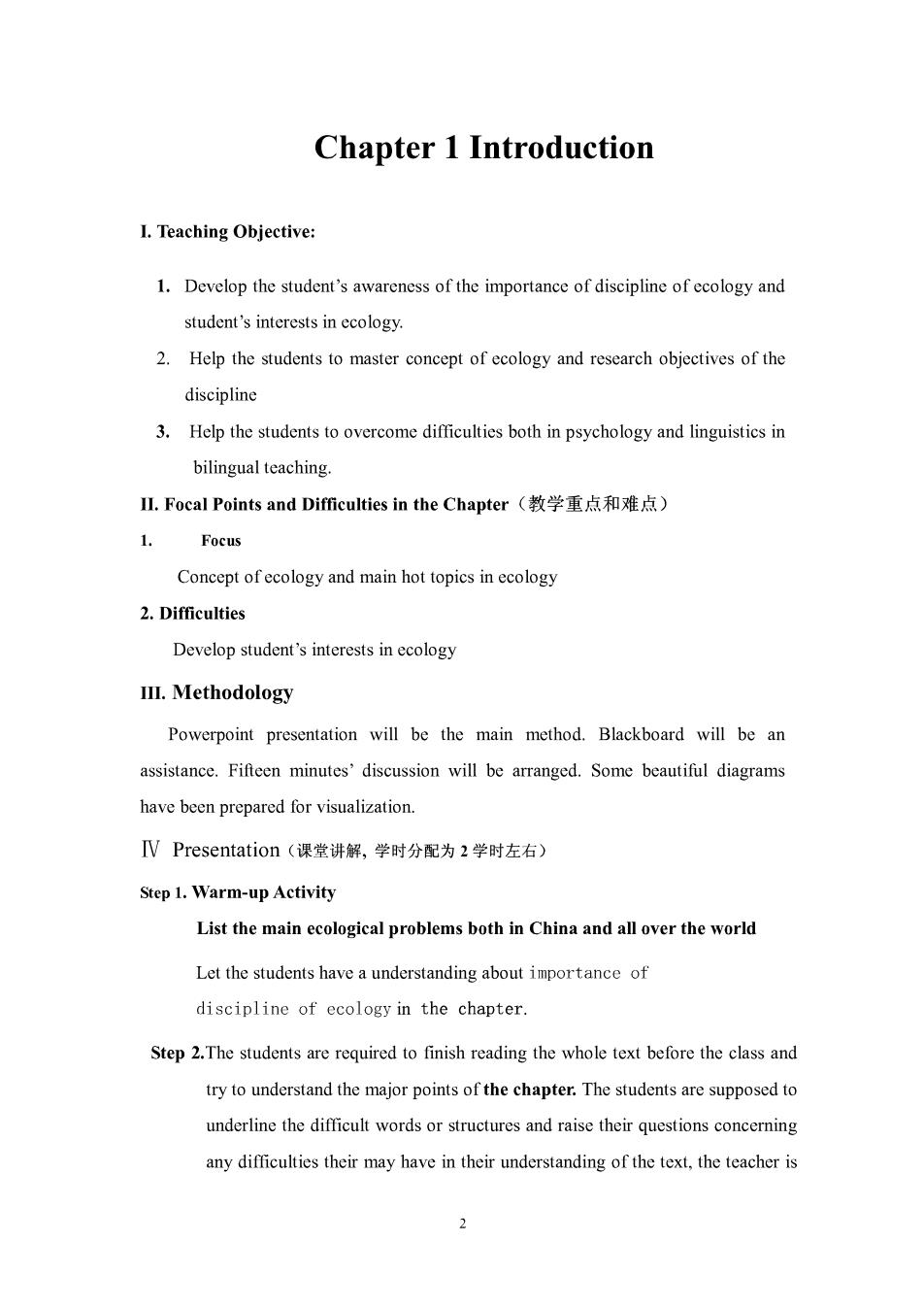
Chapter 1 Introduction I.Teaching Objective: 1.Develop the student's awareness of the importance of discipline of ecology and student's interests in ecology. 2.Help the students to master concept of ecology and research objectives of the discipline 3.Help the students to overcome difficulties both in psychology and linguistics in bilingual teaching. IL.Focal Points and Difficulties in the Chapter(教学重点和难点) 1. Focus Concept of ecology and main hot topics in ecology 2.Difficulties Develop student's interests in ccology Methodology Powerpoint presentation will be the main method.Blackboard will be an assistance.Fifteen minutes'discussion will be arranged.Some beautiful diagrams have been prepared for visualization. V Presentation(课堂讲解,学时分配为2学时左右) Step 1.Warm-up Activity List the main ecological problems both in China and all over the world Let the students have a understanding about importance of discipline of ecology in the chapter. Step 2.The students are required to finish reading the whole text before the class and try to understand the major points of the chapter.The students are supposed to underline the difficult words or structures and raise their questions concering any difficulties their may have in their understanding of the text,the teacher is
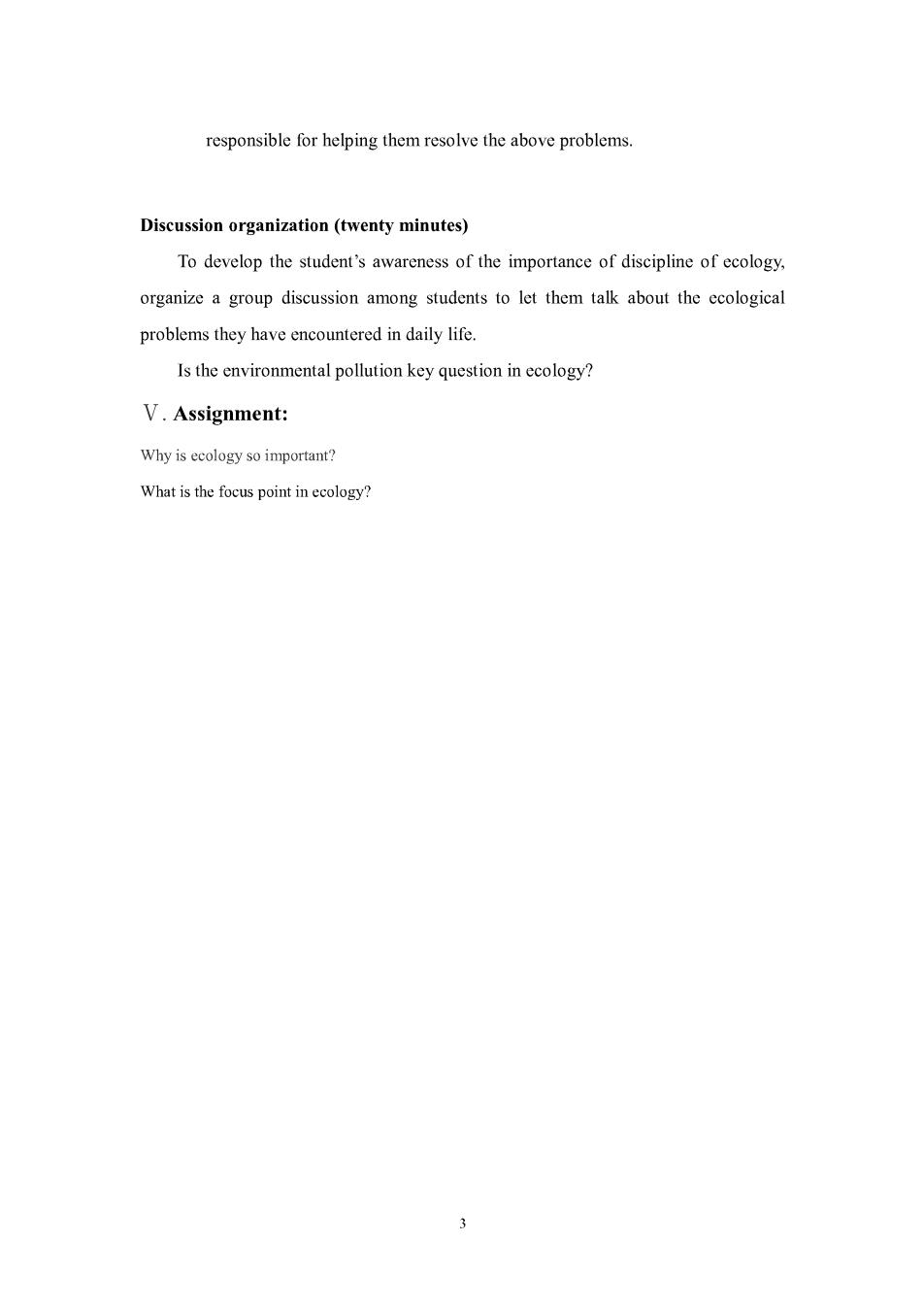
responsible for helping them resolve the above problems Discussion organization(twenty minutes) To develop the student's awareness of the importance of discipline of ecology. organize a group discussion among students to let them talk about the ecological problems they have encountered in daily life. Is the environmental pollution key question in ecology? V.Assignment: Why is ecology so important? What is the focus point in ecology?
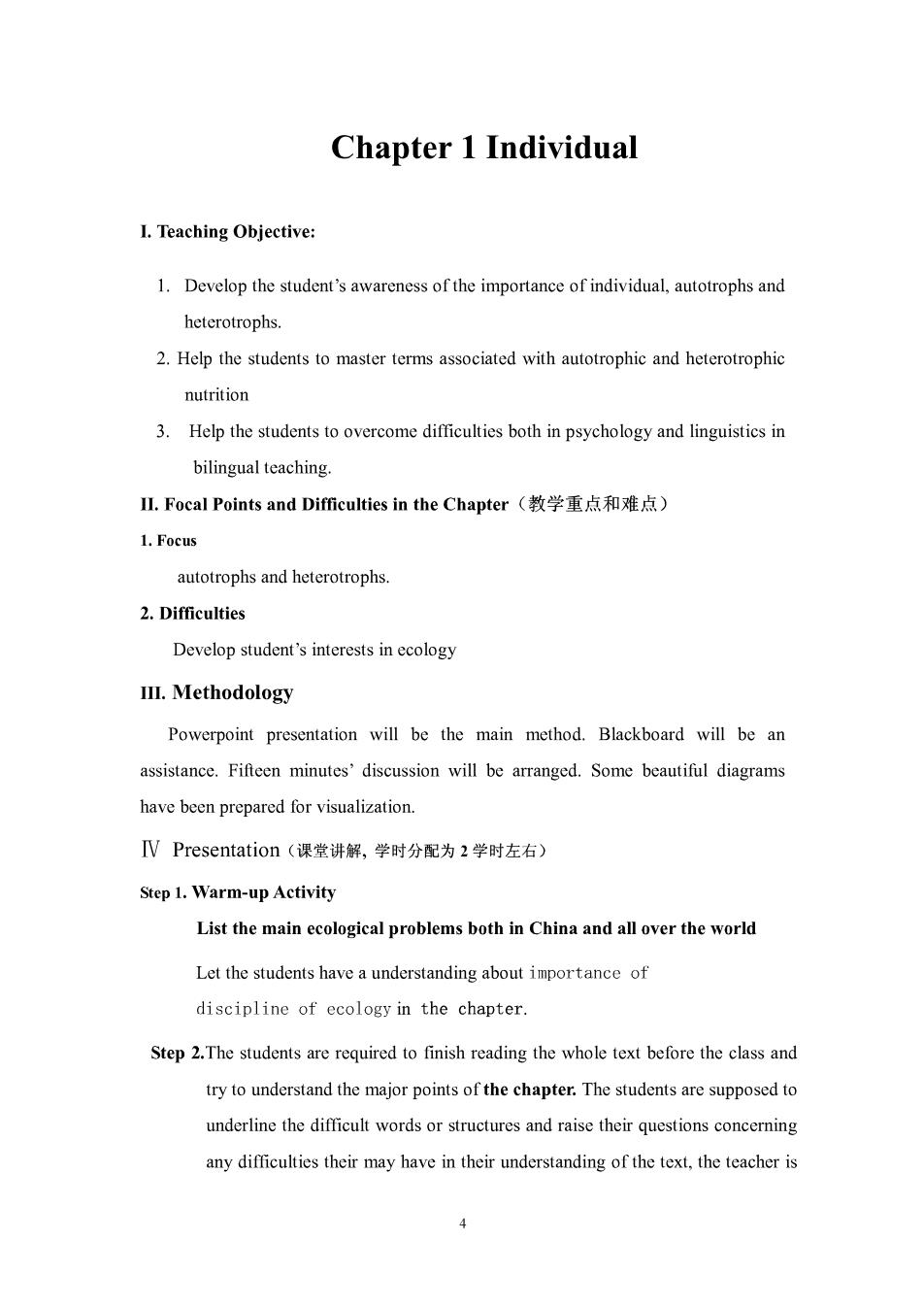
Chapter 1 Individual I.Teaching Objective: 1.Develop the student's awareness of the importance of individual,autotrophs and heterotrophs. 2.Help the students to master terms associated with autotrophic and heterotrophic nutrition 3.Help the students to overcome difficulties both in psychology and linguistics in bilingual teaching. L.Focal Points and Difficulties in the Chapter(教学重点和难点) 1.Focus autotrophs and heterotrophs. 2.Difficulties Develop student's interests in ccology Methodology Powerpoint presentation will be the main method.Blackboard will be an assistance.Fifteen minutes'discussion will be arranged.Some beautiful diagrams have been prepared for visualization. V Presentation(课堂讲解,学时分配为2学时左右) Step 1.Warm-up Activity List the main ecological problems both in China and all over the world Let the students have a understanding about importance of discipline of ecology in the chapter. Step 2.The students are required to finish reading the whole text before the elass and try to understand the major points of the chapter.The students are supposed to underline the difficult words or structures and raise their questions concering any difficulties their may have in their understanding of the text,the teacher is
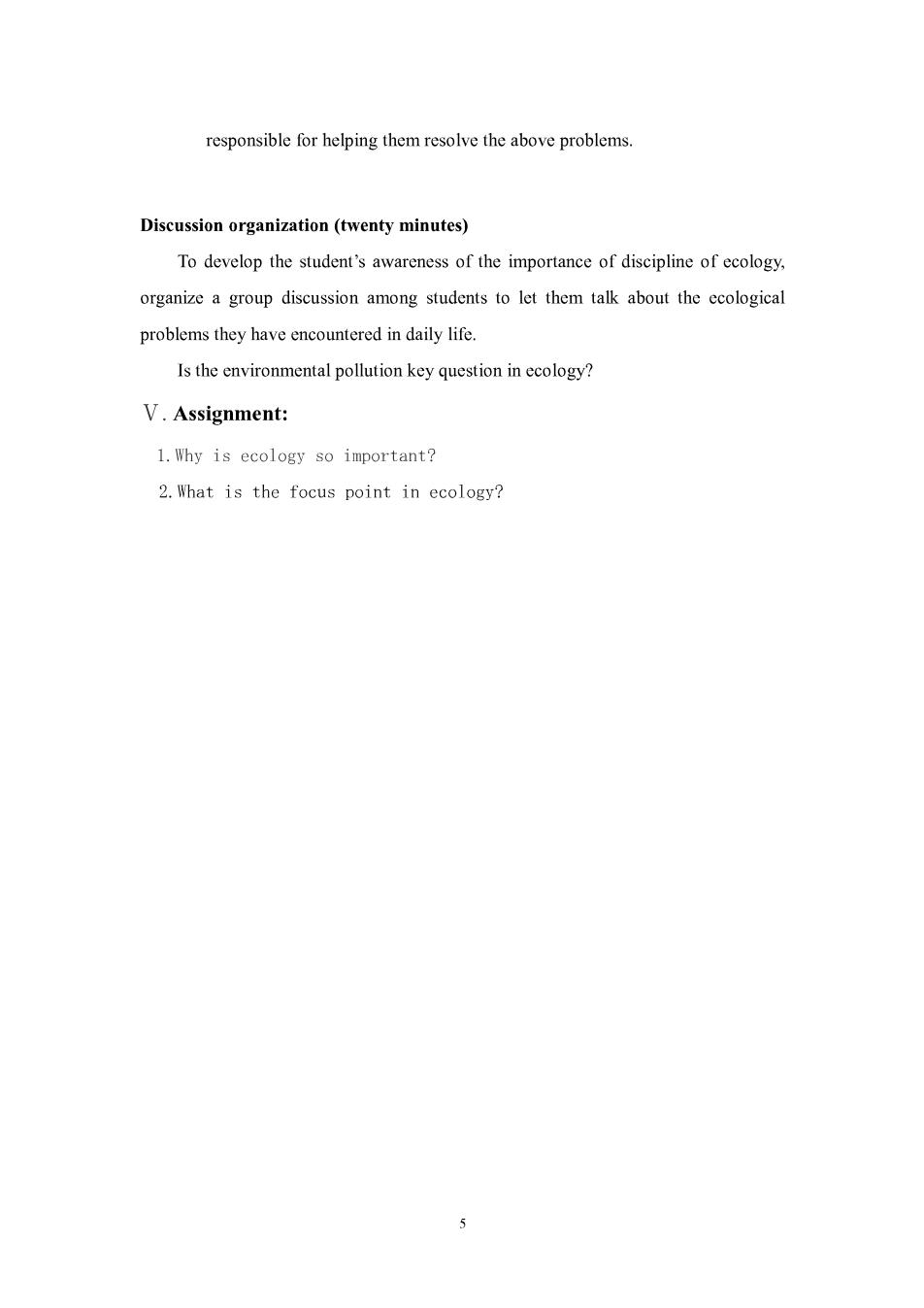
responsible for helping them resolve the above problems Discussion organization(twenty minutes) To develop the student's awareness of the importance of discipline of ecology. organize a group discussion among students to let them talk about the ecological problems they have encountered in daily life. Is the environmental pollution key question in ecology? V.Assignment: 1.Why is ecology so important? 2.What is the focus point in ecology?
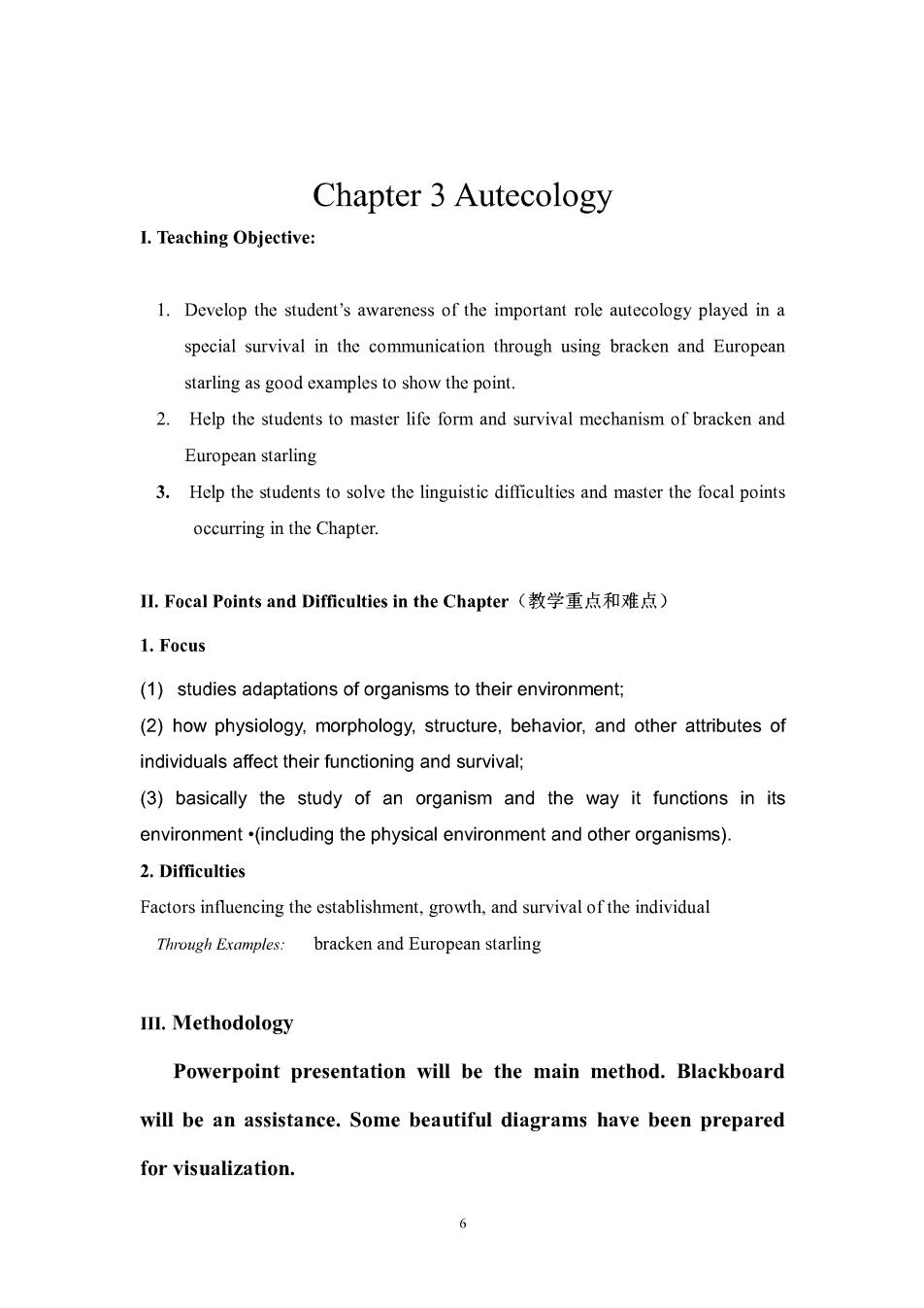
Chapter 3 Autecology I.Teaching Objective: 1.Develop the student's awareness of the important role autecology played in a special survival in the communication through using bracken and European starling as good examples to show the point. 2.Help the students to master life form and survival mechanism of bracken and European starling 3.Help the students to solve the linguistic difficulties and master the focal points occurring in the Chapter. Ⅱ.Focal Points and Difficulties in the Chapter(教学重点和难点) 1.Focus (1)studies adaptations of organisms to their environment; (2)how physiology,morphology,structure,behavior,and other attributes of individuals affect their functioning and survival: (3)basically the study of an organism and the way it functions in its environment(including the physical environment and other organisms). 2.Difficulties Factors influencing the establishment,growth,and survival of the individual Through Examples:bracken and European starling II.Methodology Powerpoint presentation will be the main method.Blackboard will be an assistance.Some beautiful diagrams have been prepared for visualization. 6
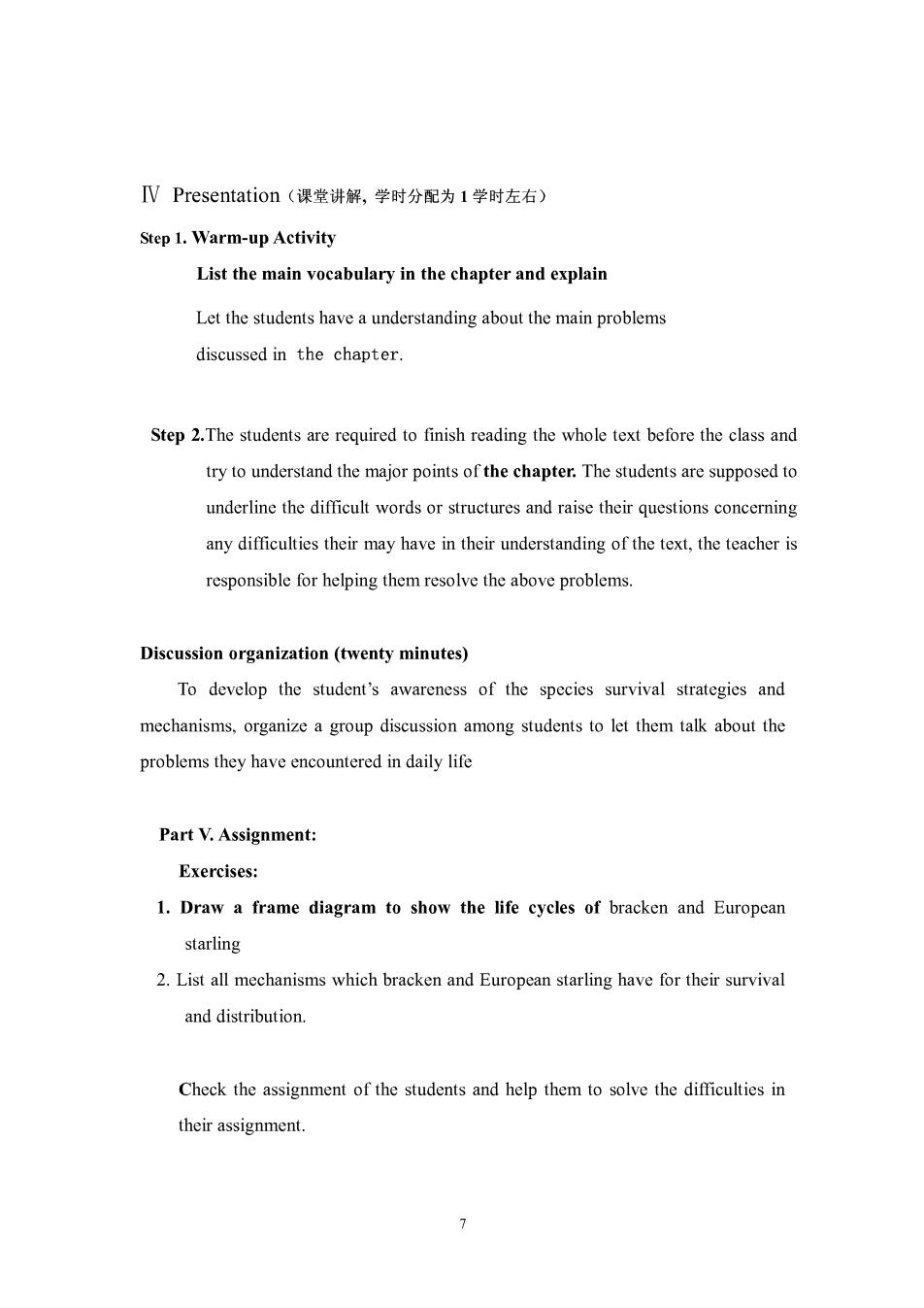
IV Presentation(课堂讲解,学时分配为1学时左右) Step 1.Warm-up Activity List the main vocabulary in the chapter and explain Let the students have a understanding about the main problems discussed in the chapter. Step 2.The students are required to finish reading the whole text before the class and try to understand the major points of the chapter.The students are supposed to underline the difficult words or structures and raise their questions concerning any difficulties their may have in their understanding of the text,the teacher is responsible for helping them resolve the above problems. Discussion organization(twenty minutes) To develop the student's awareness of the species survival strategies and mechanisms,organize a group discussion among students to let them talk about the problems they have encountered in daily life Part V.Assignment: Exercises: 1.Draw a frame diagram to show the life cycles of bracken and Europcan starling 2.List all mechanisms which bracken and European starling have for their survival and distribution. Check the assignment of the students and help them to solve the difficulties in their assignment
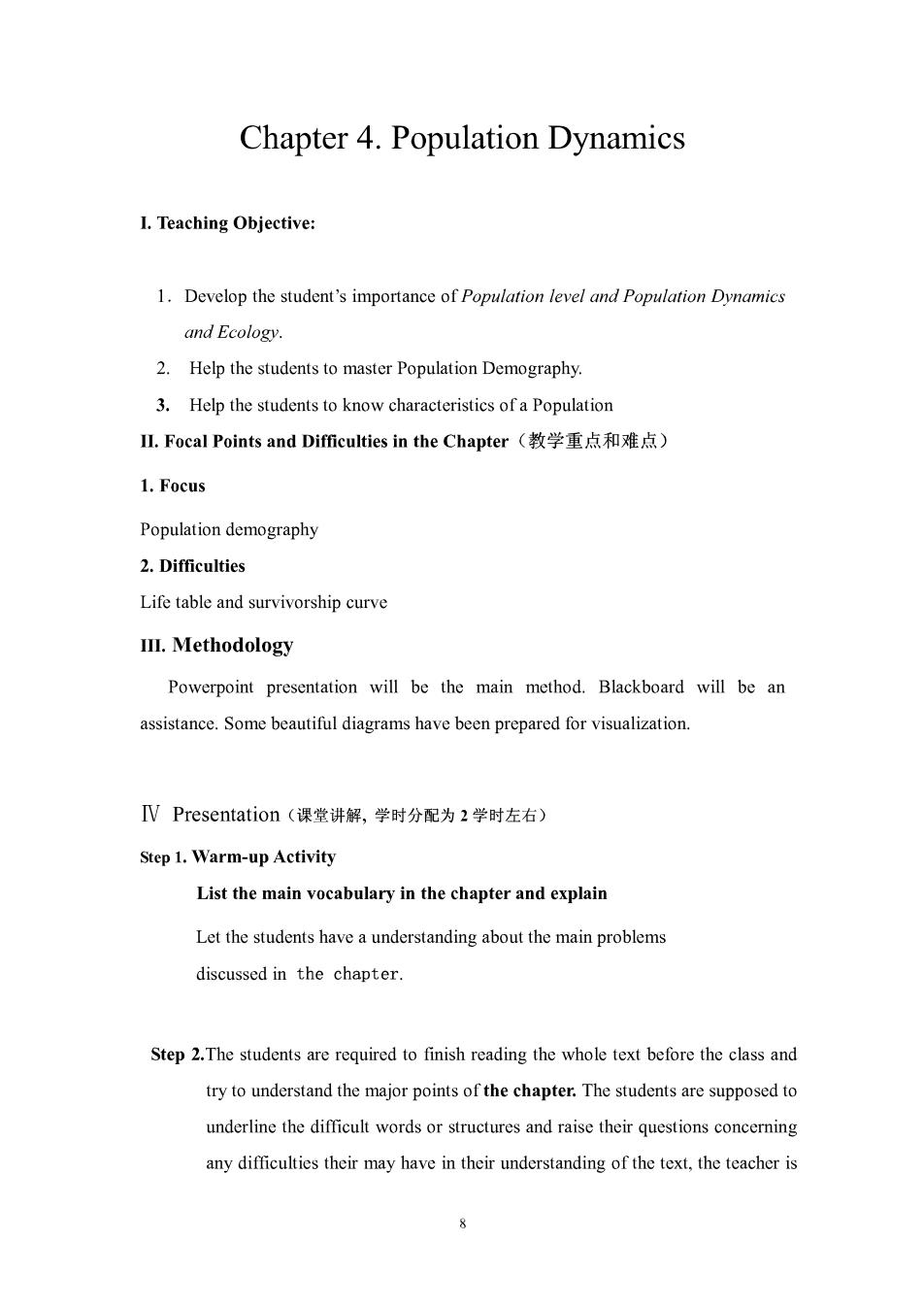
Chapter 4.Population Dynamics I.Teaching Objective: 1.Develop the student's importance of Population level and Population Dynamics and Ecology. 2.Help the students to master Population Demography. 3.Help the students to know characteristics ofa Populatior L.Focal Points and Difficulties in the Chapter(教学重点和难点) 1.Focus Population demography 2.Difficulties Life table and survivorship curve IⅢ.ethodology Powerpoint presentation will be the main method.Blackboard will be an assistance.Some beautiful diagrams have been prepared for visualization IV Presentation(课堂讲解,学时分配为2学时左右) Step 1.Warm-up Activity List the main vocabulary in the chapter and explain Let the students have a understanding about the main problems discussed in the chapter. Step 2.The students are required to finish reading the whole text before the class and try to understand the major points of the chapter.The students are supposed to underline the difficult words or structures and raise their questions concerning any difficulties their may have in their understanding of the text,the teacher is
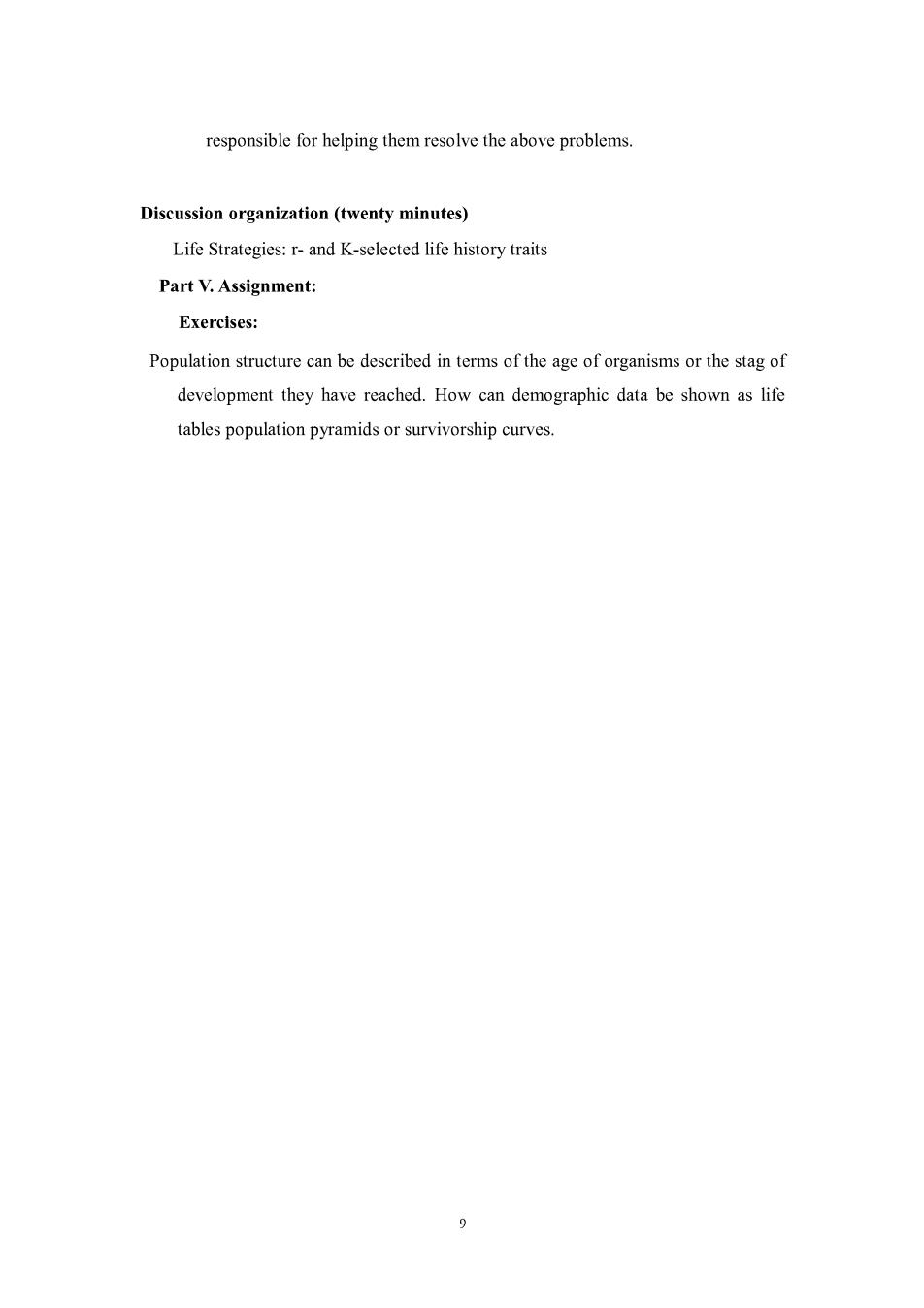
responsible for helping them resolve the above problems. Discussion organization(twenty minutes) Life Strategies:-and K-selected life history traits Part V.Assignment: Exercises: Population structure can be described in terms of the age of organisms or the stag of development they have reached.How can demographic data be shown as life tables population pyramids or survivorship curves
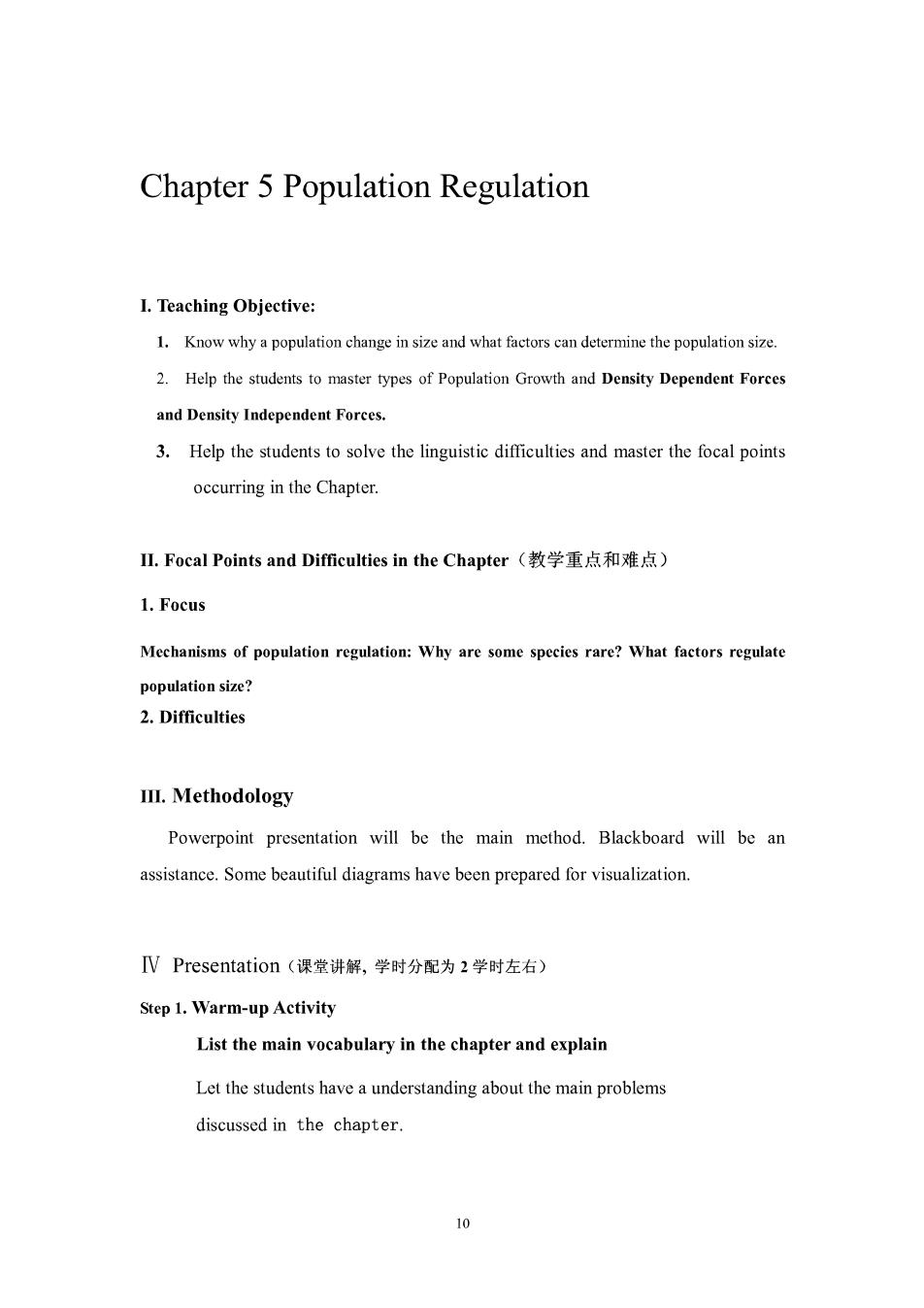
Chapter 5 Population Regulation I.Teaching Objective: 1.Know why a population change in size and what factors can determine the population size. 2.Help the students to master types of Population Growth and Density Dependent Forces and Density Independent Forces. 3.Help the students to solve the linguistic difficulties and master the focal points occurring in the Chapter. L,Focal Points and Difficulties in the Chapter(教学重点和难点) 1.Focus Mechanisms of population regulation:Why are some species rare?What factors regulate population size? 2.Difficulties II.Methodology Powerpoint presentation will be the main method.Blackboard will be an assistance.Some beautiful diagrams have been prepared for visualization. V Presentation(课堂讲解,学时分配为2学时左右) Step 1.Warm-up Activity List the main vocabulary in the chapter and explain Let the students have a understanding about the main problems discussed in the chapter